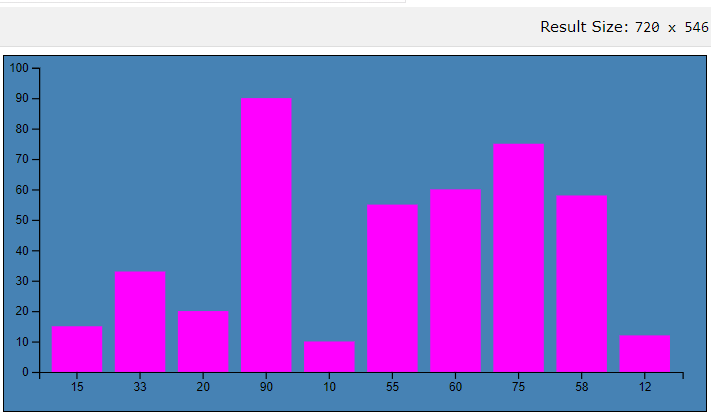D3 significa Documentos basados en datos. Es una biblioteca JavaScript de código abierto que se usa para crear visualizaciones de datos interactivas en el navegador usando HTML, SVG y CSS. La gran cantidad de datos que se generan en el mundo actual son muy difíciles de almacenar y analizar. Las representaciones visuales de datos son los medios más efectivos para transmitir la información almacenada y D3 brinda la facilidad y flexibilidad para crear estas visualizaciones de datos.
Una forma sencilla de hacer que cualquier gráfico SVG o D3.js responda. Aquí usaremos D3.js para hacer que el gráfico de barras responda.
Enfoque para crear una visualización d3.js receptiva: veamos algunos de los conceptos importantes que hemos aprendido, que se implementarán a través del código HTML a continuación.
- Seleccione un elemento para realizar la operación.
d3.select("body");
- Use el método .append() para agregar un elemento.
var svg = d3.select("body").append("svg");
- set.attr() se usa para establecer el atributo (alto/ancho)
svg.attr({"width":500, "height":500});
- El último paso es agregar los datos a DOM.
var data_values = [15, 33, 20, 90, 10, 55, 60, 75, 58, 12];
// Create rectangles
var bars = svg.selectAll("rect")
.data(data_values)
.enter()
.append("rect")
.attr("width", "25px")
.attr("height", function(d){ return d; });
- Ahora, para hacer que el gráfico responda, reemplace el alto y el ancho establecidos del gráfico, con un atributo viewBox que use los mismos valores de alto y ancho.
.attr("viewBox", `0 0 300 600`)
- El tamaño del gráfico está predefinido con una altura de 300 y un ancho de 600.
const svg = d3
.select("#chart")
.append("svg")
.attr("height", 300)
.attr("width", 600);
Ejemplo:
HTML
<!DOCTYPE html>
<html>
<head>
<title>
What is the best way to make a d3.js
visualization layout responsive?
</title>
<style>
#chart {
background: steelblue;
border: 1px solid black;
}
rect {
fill: magenta;
}
</style>
</head>
<body>
<div id="chart"></div>
<script src='https://d3js.org/d3.v5.min.js'></script>
<script id="rendered-js">
const margin = {
top: 10,
right: 20,
bottom: 30,
left: 30
};
// Dimensions: 400 x 400
// used for the initial rendering
// width to height proportion
// its preserved as the chart is resized
const width = 600 - margin.left - margin.right;
const height = 300 - margin.top - margin.bottom;
const data = [15, 33, 20, 90, 10, 55, 60, 75, 58, 12];
const xScale = d3.scaleBand().
padding(0.2).
domain(data).
range([0, width]);
const yScale = d3.scaleLinear().
domain([0, 100]).
range([height, 0]);
const svg = d3.select('#chart').
append('svg').
attr('width', width + margin.left + margin.right).
attr('height', height + margin.top + margin.bottom).
call(responsivefy) // Call responsivefy to make the chart responsive
.append('g').
attr('transform', `translate(${margin.left}, ${margin.top})`);
svg.selectAll('rect').
data(data).
enter().
append('rect').
attr('x', d => xScale(d)).
attr('y', d => yScale(d)).
attr('width', d => xScale.bandwidth()).
attr('height', d => height - yScale(d));
svg.append('g').call(d3.axisLeft(yScale));
svg.append('g').
attr('transform', `translate(0, ${height})`).
call(d3.axisBottom(xScale));
function responsivefy(svg) {
// Container is the DOM element, svg is appended.
// Then we measure the container and find its
// aspect ratio.
const container = d3.select(svg.node().parentNode),
width = parseInt(svg.style('width'), 10),
height = parseInt(svg.style('height'), 10),
aspect = width / height;
// Add viewBox attribute to set the value to initial size
// add preserveAspectRatio attribute to specify how to scale
// and call resize so that svg resizes on page load
svg.attr('viewBox', `0 0 ${width} ${height}`).
attr('preserveAspectRatio', 'xMinYMid').
call(resize);
d3.select(window).on('resize.' + container.attr('id'), resize);
function resize() {
const targetWidth = parseInt(container.style('width'));
svg.attr('width', targetWidth);
svg.attr('height', Math.round(targetWidth / aspect));
}
}
</script>
</body>
</html>
Salida: el gráfico creado cambia de tamaño cuando se cambia el tamaño de la ventana, en lugar de cortar el borde del gráfico:
- Dimensión de pantalla 720*546

- Dimensión de pantalla 590*546

- Dimensión de pantalla 330*546

Publicación traducida automáticamente
Artículo escrito por Pritesh Ranjan 1 y traducido por Barcelona Geeks. The original can be accessed here. Licence: CCBY-SA